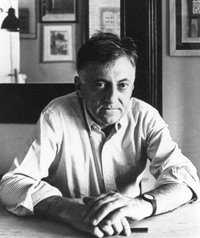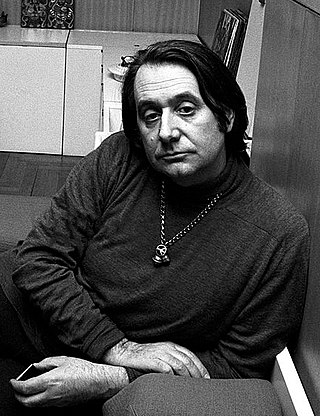Related Research Articles

Aldo Rossi was an Italian architect and designer who achieved international recognition in four distinct areas: architectural theory, drawing and design and also product design. He was one of the leading proponents of the postmodern movement.

Ettore Sottsass was a 20th-century Italian architect, noted for also designing furniture, jewellery, glass, lighting, home and office wares, as well as numerous buildings and interiors — often defined by bold colours.

The Polytechnic University of Milan is the largest technical university in Italy, with about 42,000 students. The university offers undergraduate, graduate and higher education courses in engineering, architecture and design. Founded in 1863, it is the oldest university in Milan.

Mario Bellini is an Italian architect and designer. After graduating from the Polytechnic University of Milan in 1959, Bellini pursued a career as an architect, exhibition designer, product designer, and furniture designer during the Italian economic boom of the late 20th century. Bellini has received several accolades in a variety of design fields, including eight Compasso d'Oro awards and the Gold Medal for Lifetime Achievement by the Triennale di Milano. In 2019, the Italian President of the Chamber of Deputies, Roberto Fico, awarded Bellini a career medal in recognition of his contributions to Italian architecture and design.

Cesare Colombo, known as Joe Colombo, was an Italian industrial designer.

Gaetano Pesce is an Italian architect and a design pioneer of the 20th century. Pesce was born in La Spezia in 1939, and he grew up in Padua and Florence. During his 50-year career, Pesce has worked as an architect, urban planner, and industrial designer. His outlook is considered broad and humanistic, and his work is characterized by an inventive use of color and materials, asserting connections between the individual and society, through art, architecture, and design to reappraise mid-twentieth-century modern life.

Iuav University of Venice is a university in Venice, Italy. It was founded in 1926 as the Istituto Universitario di Architettura di Venezia as one of the first Architecture schools in Italy. The university currently offers several undergraduate, graduate and higher education courses in Architecture, Urban Planning, Fashion, Arts, and Design.
John Alcorn was an American commercial artist and designer, and an illustrator of children's books. In addition to his accomplishments in the areas of packaging, corporate and dimensional design, Alcorn designed the opening titles for several Federico Fellini films. During his career, Alcorn created numerous book jackets and paperback covers, and his work appeared in many major exhibits.

Satyendra Pakhalé is a multifaceted designer, artist, industrial designer, and architect. He realizes projects in art, design, industrial design, applied research to design vision of the future, technologically challenging product development, manufacturing, highly crafted pieces, exhibitions, and architecture. He works in the fields of art, design, exhibition design, product design, including consumer electronics, health care, aviation, mobility, home appliances, furniture, digital products & computers, and interior design and architecture. In 2008, he was selected as one of L’Uomo Vogue magazine's 80 most influential creative people with a vision worldwide in art, design and architecture. His works are in the permanent collections of several museums worldwide.

Carlo Ratti is an Italian architect, engineer, educator and author. He is a professor at the Massachusetts Institute of Technology where he directs the MIT Senseable City Lab, a research group that explores how new technologies are changing the way we understand, design and ultimately live in cities. Ratti is also a founding partner of the international design and innovation office CRA-Carlo Ratti Associati, which has offices in Turin, New York and London. He is also a Distinguished Professor in the Department of Architecture, Built Environment and Construction Engineering at the Politecnico di Milano and an Honorary Professor at TTPU Tashkent. Ratti was named one of the "50 most influential designers in America" by Fast Company and highlighted in Wired magazine's "Smart List: 50 people who will change the world".

Franco Albini was an Italian Neo-Rationalist architect, designer and university instructor in design.
Arturo Vittori, is an Italian artist, architect, and industrial designer. He is co-founder and director of the architecture and design team Architecture and Vision.
Andreas Vogler is a Swiss architect, designer and artist. He is founder and director of the architecture and design firm, Andreas Vogler Studio.
Alberto Meda is an Italian engineer and designer. His work is held in museums around the world. He works and lives in Milan.

Kamal Amin Awad (1923–1979) was a pioneering Egyptian artist in the field of graphic arts.
Ivan Picelj was a contemporary Croatian painter, sculptor and graphic designer.

Emilio Ambasz is an Argentinian-US architect and award-winning industrial designer. From 1969 to 1976 he was Curator of Design at the Museum of Modern Art, in New York. Ambasz has been labeled as "the father, poet, and prophet" of the green architecture by Japanese architect Tadao Ando.

Afra and Tobia Scarpa are award winning postmodern Italian architects and designers. Their pieces can be found in museums across the United States and Europe, including collections in MoMA and the Louvre Museum. They have collaborated with companies such as B&B Italia, San Lorenzo Silver, and Knoll International. They have won a number of awards such as the Compasso d'Oro in 1969 to the International Forum Design in 1992. Their design work consists of architecture and everyday household items including, furniture, clothing, interior design, art glass. They focused on the technical and aesthetic possibilities of materials in their designs. The couple was greatly influenced by Tobia’s father, Carlo Scarpa, a Venetian architect and designer.

Janez Bernik was a multiple-time awarded and internationally acclaimed Slovenian painter and academic.
Franco Grignani was an Italian architect, graphic designer and artist. He is best known for black and white graphics, particularly the Woolmark logo, which was voted 'Best Logo of all Time' by Creative Review Magazine in 2011.
References
- ↑ "Dom in vrt.si (in Slovene)" . Retrieved 6 July 2012.
- ↑ "The Kogoj Gallery (in Slovene)" . Retrieved 6 July 2012.
- ↑ "The Kogoj Gift Shop(in Slovene)" . Retrieved 6 July 2012.
- ↑ "The Kogoj Gallery (in Slovene)" . Retrieved 6 July 2012.